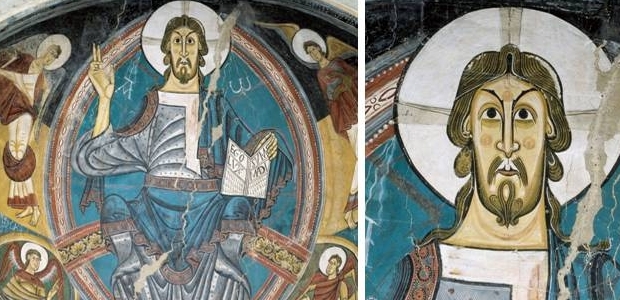How many times have we seen this image? Many, for sure. And more so, taking into account that it has recently been very present in the press. The discovery of the remains of paint, or the deeper layers, has been in the news, in the church itself of Sant Climent de Taüll and also the virtual reproduction of the image that has been done there (with prize included). Just a few days ago, it was chosen by popular vote as the most representative painting of Barcelona.
This serene face of the Pantocrator (or Christ in Majesty, as art historians recommend we call it), is one that we all have highly incorporated in our imagery. So much so, that it has become an authentic icon and that, therefore, you don’t need to pay attention to the small details to recognise it. In the same way that you don’t need to spend time looking at the profile of a trunk, for example, to recognise a tree. We only do so when we want to draw it. This specific and highly directed look, as an artist, is precisely the one we need when we dedicate ourselves to studying the materials of the works of art.
Discovery, the result of the study
The study involves us approaching the details, getting closer and closer. In this case, we find the halo with the cross surrounding the face. And on the arms, or patibulum, of this cross, there are some very visible drawn lines that it is very difficult to believe that they formed part of the finished work. It’s possible that they were hidden. Or maybe they were covered with paint that has now been lost. Or they could have been under a metal sheet, like the one which is found on the frontal part of Romanesque altarpieces over similar iconographic elements. In fact, next to the lines, in various areas, the presence can be observed of black remains that could be dirt or some more significant material.

Localisation of the point of the sample of the remains of the cross of the halo of the Christ of Sant Climent de Taüll.
Taking advantage of the setting up of the scaffolding to make the rubbings of the apse of Sant Climent, an exhaustive collection of samples was made of different elements of the mural painting with the intention of answering questions regarding the execution technique. It was therefore pertinent to get a representative micro-sample of these black remains of the halo cross and to shed the doubts.
The analysis has served to determine that these are remains of altered metal, specifically tin. The golden part, with a strong symbolic value, was a much-used resource for highlighting and showing the hierarchy of certain elements in a pictorial composition throughout the Middle Ages. The use of sheets of gold was very extensive during the whole of the Gothic production. But other metals were also used such as silver and tin to create false gold. The metal sheets were covered in varnishing, that is to say, coloured varnish that manages to imitate the tonality of gold. There are different recipes that explain how to do this, contained in former treaties such as that of Theophilus or the Manuscript of Montpellier.
There are various Romanesque works of the museum that contain tin, the Altar frontal from Ix or the Altar frontal of the Apostles or from La Seu d’Urgell, to mention two, or the Batlló Majesty itself. But never before until now has there been evidence that in the Romanesque mural painting of the collection of the Museu Nacional d’Art de Catalunya that this resource been used.

Points in which tin can be found in the Altar frontal of the Apostles or from La Seu d’Urgell.
A small sample of the grey polychrome has also been analysed of the subpedaneum of the Christ crucified of the mural paintings of Sorpe, and the presence has been detected of pewter, tin alloy and lead.

Localisation of the point of the sample of the Crucifixion of Sorpe.
The scoop on the blog
The analysis of these samples with the respective results, due to being a novelty, will be presented from 11th to 13th June, in the next congress Art’14 which will deal with non-destructive techniques of analysis and micro-analysis. We can advance, now and here, if you allow us to do so…the scoop.
The art historians value this data in the sense that they let us make comparisons with other works which contain similar materials and to establish connections. In France there is tin in the pictorial collections of Moissac (Tarn-et-Garonne) from the 12th century, or in Saint Nicolas (Nogaro) and the Romanesque doorway itself of Cluny (1115-1129). In the cross of the halo in Christ in Majesty of the portal of Ripoll pewter has also recently been found. It seems that the technique of Romanesque painters of walls didn’t differ much from that of other artists, or perhaps were even the same.
This is just an example of the information that can be extracted by taking a close look at the Christ of Sant Climent de Taüll. We will continue working on this, and for sure there will be more new news.
By the way, if the Pantocrator of Taüll, or Christ in Majesty, is an icon, will we now be able to imagine ourselves in the halo of the golden cross?
Restauració i Conservació Preventiva








